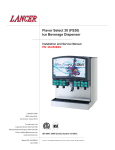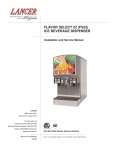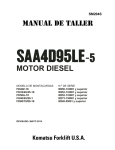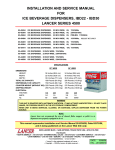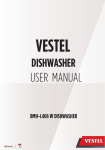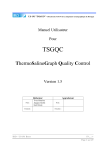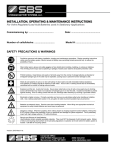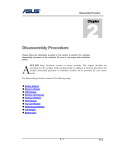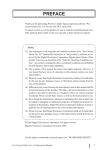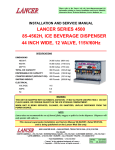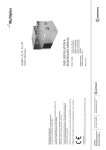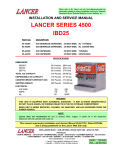Download flavor select 30 (fs30) ice beverage dispenser - Soda
Transcript
INSTALLATION AND SERVICE MANUAL FOR FLAVOR SELECT 30 (FS30) ICE BEVERAGE DISPENSER LANCER SERIES 14800 85-14808-12 ICE BEVERAGE DISPENSER, ABOVE COUNTER MULTI BRAND, 30 INCH WIDE, 8 BRANDS / 12 FLAVORS, 115V/60Hz 85-14808N-12 ICE BEVERAGE DISPENSER, ABOVE COUNTER MULTI BRAND, 30 INCH WIDE, 8 BRANDS / 12 FLAVORS, 115V/60Hz 85-14810-12 ICE BEVERAGE DISPENSER, ABOVE COUNTER MULTI BRAND, 30 INCH WIDE, 10 BRANDS / 12 FLAVORS, 115V/60Hz 85-14810N-12 ICE BEVERAGE DISPENSER, ABOVE COUNTER MULTI BRAND, 30 INCH WIDE, 10 BRANDS / 12 FLAVORS, 115V/60Hz 85-14812-12 ICE BEVERAGE DISPENSER, ABOVE COUNTER MULTI BRAND, 30 INCH WIDE, 12 BRANDS / 12 FLAVORS, 115V/60Hz 85-14812N-12 ICE BEVERAGE DISPENSER, ABOVE COUNTER MULTI BRAND, 30 INCH WIDE, 12 BRANDS / 12 FLAVORS, 115V/60Hz 85-14814-12 ICE BEVERAGE DISPENSER, ABOVE COUNTER MULTI BRAND, 30 INCH WIDE, 14 BRANDS / 12 FLAVORS, 115V/60Hz 85-14814N-12 ICE BEVERAGE DISPENSER, ABOVE COUNTER MULTI BRAND, 30 INCH WIDE, 14 BRANDS / 12 FLAVORS, 115V/60Hz 85-14816-12 ICE BEVERAGE DISPENSER, ABOVE COUNTER MULTI BRAND, 30 INCH WIDE, 16 BRANDS / 12 FLAVORS, 115V/60Hz 85-14816N-12 ICE BEVERAGE DISPENSER, ABOVE COUNTER MULTI BRAND, 30 INCH WIDE, 16 BRANDS / 12 FLAVORS, 115V/60Hz PELLET ICE PELLET ICE PELLET ICE PELLET ICE PELLET ICE This manual supersedes and replaces 28-0558/01, dated 03/17/05. 6655 LANCER BLVD. • SAN ANTONIO, TEXAS 78219 USA • (210) 310-7000 FAX SALES • NORTH AMERICA – 210-310-7245 • INTERNATIONAL SALES – 210-310-7242 • CUSTOMER SERVICE – 210-310-7242 • • LATIN AMERICA – 210-310-7245 • EUROPE – 32-2-755-2399 • PACIFIC – 61-8-8268-1978 • FAX Engineering: • 210-310-7096 "Lancer" is the registered trademark of Lancer • Copyright — 2006 by Lancer, all rights reserved DATE: 03/06/06 P.N. 28–0558/02 SPECIFICATIONS DIMENSIONS 30" WIDE HEIGHT: WIDTH: DEPTH: 39.625 INCHES (100.7 cm) 30.00 INCHES (76.2 cm) 30.50 INCHES (77.5 cm) TOTAL ICE CAPACITY: 280 LBS (127.0 KG) DISPENSABLE ICE CAPACITY: 210 LBS ( 95.3 KG) COUNTER WEIGHT (WITHOUT ICE): 390 LBS (177.0 KG) SHIPPING WEIGHT: 420 LBS (138.6 KG) ELECTRICAL VOLTAGE: AMPS: Hz: 115 7.0 60 WARNING THIS UNIT IS EQUIPPED WITH AUTOMATIC AGITATION. IT MAY ACTIVATE UNEXPECTEDLY. DO NOT PLACE HANDS, OR FOREIGN OBJECTS IN THE ICE STORAGE COMPARTMENT. WHEN UNIT IS BEING SERVICED, CLEANED, OR SANITIZED, UNPLUG DISPENSER FROM THE POWER SOURCE. NOTE Lancer does not recommend the use of shaved, flake, nugget, or pellet ice in dispensers not properly equipped to do so (see Section 6.2, this manual). 29" (737 mm) 26 1/2" (673 mm) 30" (762 mm) 8 3/4" (222 mm) 14 5/8" (372 mm) 18 3/4" (476 mm) 4 1/2" (114 mm) 39 5/8" (1006 mm) 5 1/2" (140 mm) 10" (254 mm) 23" (584 mm) 7 1/2" (190 mm) 5 1/8" (130 mm) 30 1/2" (775 mm) The FS30 Dispenser, Lancer Series 14800 i MANUFACTURERS INTRODUCTION - High Volume Free Standing Fountain Drink Dispenser The unit is designed with the highest quality components to be user and service friendly. The FS30 is designed to be ready to use out-of-the-box as long as there is a steady water supply, BIB (Bag-In-Box) syrups with their pumps, and a regulated CO2 supply. It will seamlessly interface with the Lancer Ice Link ice transport system to provide for a minimum of labor and maintenance by store personnel. The FS30 features a casted-in cold carbonator within the cold plate. It has a removable probe that regulates the mixture of CO2 and plain water. The unit is equipped with a pressure (PSI) relief valve and a maintenance-free water pump with backflow preventer for the carbonator. The cold plate has been designed and tested to meet the highest performance and health standards. The design allows for a single drain and the ability for up to 16 independent brands to be dispensed through four (4) Lancer Multi-Flavor dispense nozzles. A total of 12 "bonuses" (ambient flavors) may be added to the drink via the flavor injection system on four (4) nozzles. The bonus flavors are plumbed independently to each of the nozzles allowing for a multitude of customer pleasing drink combinations. Supplier Name: Address: Phone: Lancer 6655 Lancer Blvd San Antonio, TX 78219 (800) 729-1500 Local Service Name: __________________________________________ Local Service Phone #: ________________________________________ TABLE OF CONTENTS SPECIFICATIONS...............................................................................................................................................i MANUFACTURERS INTRODUCTION ..............................................................................................................ii TABLE OF CONTENTS .....................................................................................................................................ii 1. INSTALLATION ...........................................................................................................................................1 1.1 RECEIVING........................................................................................................................................1 1.2 UNPACKING ......................................................................................................................................1 1.3 SELECTING COUNTER LOCATION .................................................................................................2 1.4 INSTALLING THE DISPENSER.........................................................................................................2 1.5 OPTIONAL INSTALLATION OF SOLD-OUT DEVICE .......................................................................4 2. CLEANING AND SANITIZING INSTRUCTIONS ........................................................................................4 2.1 GENERAL INFORMATION ................................................................................................................4 2.2 REQUIRED CLEANING EQUIPMENT...............................................................................................5 2.3 DAILY CLEANING ..............................................................................................................................5 2.4 ICE BIN CLEANING - START UP AND MONTHLY ...........................................................................6 2.5 CLEANING AND SANITIZING BEVERAGE COMPONENTS - FIGAL SYSTEMS............................6 2.6 CLEANING AND SANITIZING BEVERAGE COMPONENTS - BAG-IN-BOX SYSTEMS.................7 3. HOW TO OPERATE AND ADJUST THE LANCER FS30 ..........................................................................8 3.1 NORMAL OPERATION ......................................................................................................................8 3.2 PROGRAMMING AND SETUP SOFTWARE.....................................................................................8 3.3 PURGING THE CARBONATION SYSTEM .....................................................................................10 3.4 PURGING THE WATER AND SYRUP SYSTEM .............................................................................10 3.5 ADJUSTING WATER FLOW (LFCV®) .............................................................................................10 3.6 WEEKLY ADJUSTING OF WATER TO SYRUP (RATIO) BRIX (LFCV®) ........................................11 3.7 CARBONATOR PUMP MODIFICATIONS........................................................................................11 3.8 PRIMING THE SYRUP PUMP AT THE CORRECT PRESSURE ....................................................11 3.9 REPLENISHING BIB (BAG-IN-BOX) SYRUP SUPPLY ...................................................................11 4. TROUBLESHOOTING GUIDE FOR THE FS30 DISPENSER..................................................................12 5. EXTRA CAPABILITIES .............................................................................................................................15 5.1 AUTOMATIC AGITATION AND RESETTABLE BREAKER..............................................................15 5.2 DIAGNOSTIC ...................................................................................................................................15 6. ILLUSTRATIONS, PARTS LISTINGS, AND WIRING DIAGRAMS ..........................................................17 6.1 FINAL ASSEMBLY ......................................................................................................................17-18 6.2 PELLET ICE ASSEMBLY AND PARTS LISTING.............................................................................19 6.3 WIRING DIAGRAM - 115V/60HZ (FIGURE SCHEMATICS) ...........................................................20 6.4 PLUMBING DIAGRAM WITH VALVE WIRING................................................................................21 ii 1. INSTALLATION 1.1 RECEIVING Each unit is completely tested under operating conditions and thoroughly inspected before shipment. At time of shipment, the carrier accepts the unit and any claim for damage must be made with the carrier. Upon receiving units from the delivering carrier, carefully inspect carton for visible indication(s) of damage. If damage(s) exist(s), have carrier note same on bill of lading and file claim with carrier. 1.2 UNPACKING A. B. C. D. E. Set shipping carton upright on the floor. Cut band and remove. Open top of carton and remove interior packing. Lift carton up and off of the dispenser. Remove wood shipping base from the bottom of the dispenser. (Support dispenser while removing shipping base to prevent damage to the dispenser.) NOTE: Please refer to specific icemaker model for proper air intake/exhaust ventilation with Lancer units. 39.625" (1006.5 mm) SUFFICIENT CLEARANCE FOR FILLING MANUALLY WITH ICE, WHEN ICE MAKER NOT USED 10" (254 mm) DISPENSE HEIGHT 30 1/2" (775 mm) MINIMUM of 6" (152 mm) clearance above ice maker UT AI AIR AIR T OU AI R IN IN MINIMUM of 6" (152 mm) wall clearance 39.625" (1006.5 mm) 6" (152 mm) clearance 6" (152 mm) clearance T U O R R O R AI OU T AI MINIMUM of 6" (152 mm) clearance above ice maker 30" (762 mm) 30 1/2" (775 mm) Figure 1 1 1.3 SELECTING COUNTER LOCATION (SEE FIGURE 1) WARNING THIS APPLIANCE MUST BE EARTHED. THIS DISPENSER MUST BE ELECTRICALLY GROUNDED TO AVOID DANGER TO THE OPERATOR. THE POWER CORD PROVIDED HAS A THREE PRONG GROUNDED PLUG. IF A THREE HOLED GROUNDED ELECTRICAL OUTLET IS NOT AVAILABLE, USE AN APPROVED METHOD OF INSURING A PROPER GROUND TO THE DISPENSER. CAUTION FAILURE TO DISCONNECT THE MOTOR POWER SUPPLY WILL DAMAGE THE CARBONATOR MOTOR AND PUMP AND VOID THE WARRANTY. A. Select a location close to a properly grounded 20 Amp electrical outlet, convenient to an open type drain, access for soda, water, and syrup lines. It should have sufficient clearance above the unit to provide for servicing. 1. If at all possible, location should be away from direct sunlight or other heat sources. 2. Connecting lines may be run through access in back of the unit or extend down through a counter cutout. 3. Check the dispenser serial number plate for correct electrical requirements of unit. Do not plug into wall electrical outlet unless the current shown on the serial number plate agrees with local current available. 4. The counter must support the weight of the dispenser, ice, and possibly an icemaker. Total weight may exceed 800 pounds (363.6 kg). B. Unit may be installed directly on the countertop or on optional leg kit (PN 82-3484). If installed directly on the counter, the unit must be sealed to the countertop. If an icemaker is to be mounted on top of dispenser, do not install dispenser on legs. NOTE Water pipe connections and fixtures directly connected to a potable water supply must all be sized, installed, and maintained according to Federal, State, and Local laws. The water supply must be protected by means of an air gap, a backflow prevention device (located upstream of the CO2 injection system) or another approved method to comply with NSF standards. A backflow prevention device must comply with ASSE and local standards. It is the responsibility of the installer to ensure compliance. C. Location must insure sufficient clearance on sides, top and back of unit is provided for ventilation and air circulation (see Figure 1). D. Additionally, if an ice maker is not top mounted on the unit, sufficient clearance should be provided [a minimum of 16 inches (40.6 cm) is recommended] to allow filling the unit with ice from a five (5) gallon (19 liter) container (see Figure 1). 1.4 INSTALLING THE DISPENSER A. Remove Cup Rest, Drip Tray, Splash Plate, and Top Cover. B. Remove Cover Plate at rear of unit if not a through-the-counter installation. C. Connect plain water supply line and water supply for carbonator to the 3/8 inch barb fittings at the front of the unit (See Figure 2). D. For the plain water supply line, the inlet water flowing pressure should be at least 75 PSI. If the water pressure is lower than 75 psi flowing, a Water Booster system must be used. NOTE: The Lancer Water Booster/Tank, PN MC-163172, is offered as a kit. The Water Booster must be installed as close as possible to the plain water circuit inlet. If the water flowing pressure is lower than 75 PSI at the plain water inlet, and a water booster is NOT installed, all water products will not hold a proper flow rate and/or water/syrup ratio. Additionally, flow conditions at the nozzle may be affected, for example, poor nozzle coning and mixing. 2 E. For the soda water supply line, the inlet water static pressure going into the carbonator pump should NOT exceed 50 PSI. If the static water pressure exceeds 50 psi, a water regulator must be installed before the carbonator water inlet. NOTE: The regulator (Lancer PN 18-0306) must be installed as close as possible to the water carbonator pump inlet. The water pressure value feeding the carbonator is recommended to be at a minimum of 25 PSI. If the normal water pressure does not exceed 50 psi, but fluctuates over this value (for example, when water usage on other equipment connected to the same water supply causes pressure “spikes”), the use of a water regulator is also required. F. G. H. I. J. K. L. Place CO2 Cylinder with regulator in a serviceable location and route CO2 supply line (75 PSI) to the 1/4 inch flare fitting at the front of the unit (See Figure 3). Check for leaks. Connect syrup supply lines to the 3/8 inch barb inlet fittings at the front of the unit (See Figure 4), using BIB (Bag-In-Box) pumps. Check for leaks. Connect flavor injection lines to the barb fittings at the front of the unit (See Figure 4). Check for leaks. Install Drip Tray and extend hose to open type drain. Drain lines must be insulated with a closed cell insulation. Insulation must cover the entire length of the drain hose, including fittings. The drain should be installed in such a manner that water does not collect in sags or other low points, as condensation will form. Install Cup Rest and Splash Plate. Connect Power Cord to grounded electrical outlet. WARNING: ICE AUGER AND BIN AGITATION SYSTEM WILL OPERATE AUTOMATICALLY. PLACE HANDS OR ANY BODY PARTS WITHIN THE BIN OR IN THE ICE CHUTE. M. Test Motor operation by pushing Ice Chute. Flavor Injection Inlets Water Inlets Figure 2 Syrup Connections Figure 4 CO2 Inlet Figure 3 3 DO NOT N. O. P. Q. Clean and sanitize dispenser (see Section 2). Fill unit approximately half full with ice. Push Chute and check for ice delivery. Fill unit with ice. Install Top Cover. NOTE Lancer does not recommend the use of shaved, flake, nugget, or pellet ice in dispensers not properly equipped to do so (see Section 6.2, this manual). R. Set brix ratio for beverage dispensing valves according to manufacturer's instructions. IMPORTANT NOTICE WHEN INSTALLING AN ICEMAKER ON AN IBD UNIT, A BIN THERMOSTAT OR OTHER MEANS OF CONTROLLING THE ICE LEVEL MUST BE INSTALLED. FAILURE TO DO SO COULD RESULT IN DAMAGE TO THE DISPENSING MECHANISM AND VOID THE WARRANTY. DURING THE AUTOMATIC AGITATION CYCLE AND/OR WHILE DISPENSING ICE, THERE MUST BE ADEQUATE ROOM BETWEEN THE TOP OF THE ICE LEVEL AND THE BOTTOM OF THE ICEMAKER SO THAT THE ICE CAN MOVE WITHOUT OBSTRUCTION. CONTACT YOUR ICEMAKER SUPPLIER FOR INFORMATION ON PROPER BIN THERMOSTAT. CAUTION BEFORE REMOVING ANY PARTS IN THE BIN, ENSURE THE UNIT IS DISCONNECTED FROM THE POWER SOURCE. AUTOMATIC AGITATION MAY GO OFF AT ANY TIME, AND THE AGITATOR MAY CAUSE INJURY. 1.5 OPTIONAL INSTALLATION OF SOLD-OUT DEVICE A. An optional Sold-Out Device can be used to automatically shut off the Syrup Pump when the Package(s) is empty. This stops the operation of the Pump and the exhaust of gas until a new syrup package is connected to the Pump. B. The Lancer Sold-Out device measures syrup vacuum in the Pump Inlet Line. When the Syrup Package is empty, the Pump increases vacuum causing the device to shut off the gas pressure to stop the Pump. The Lancer Sold-Out automatically resets, after new Syrup Packages are connected. 2. CLEANING AND SANITIZING INSTRUCTIONS 2.1 GENERAL INFORMATION A. Lancer equipment (new or reconditioned) is shipped from the factory cleaned and sanitized in accordance with NSF guidelines. This equipment must be cleaned and sanitized after installation is complete, and the operator of the equipment must provide continuous maintenance as required by this manual and/or state and local health department guidelines to ensure proper operation and sanitation requirements are maintained. NOTE The cleaning and sanitizing procedures provided herein pertain to the Lancer equipment identified by this manual. If other equipment is being cleaned, follow the guidelines established for that equipment. B. Cleaning and sanitizing should be accomplished only by trained personnel. Sanitary gloves are to be used during cleaning and sanitizing operations. Applicable safety precautions must be observed. Instruction warnings on the product being used must be followed. C. Water lines are not to be disconnected during the cleaning and sanitizing of syrup lines to avoid contamination. D. Do NOT use strong bleaches or detergents. They tend to discolor and/or corrode various materials. E. Do NOT use metal scrapers, sharp objects, steel wool, scouring pads, abrasives, solvents, etc., on the dispenser. F. Do NOT use hot water above 140°F (60°C). This may damage certain materials. 4 2.2 REQUIRED CLEANING EQUIPMENT A. Cleansers (for example, Ivory Liquid, Calgon, etc.) mixed with clean, potable water at a temperature of 90 to 110 degrees Fahrenheit should be used to clean equipment. The mixture ratio, using Ivory Liquid, is one (1) ounce of cleanser to two (2) gallons of water. A minimum of five (5) gallons of cleaning mixture should be prepared. Any equivalent cleanser may be used as long as it provides a caustic based, non-perfumed, easily rinsed mixture containing at least two (2) percent sodium hydroxide (NaOH). Rinsing must be thorough and use clean, potable water which is also at a temperature of 90° to 110°F. NOTE Extended lengths of product lines may require that an additional volume of cleaning solution be prepared. B. Sanitizing solutions should be prepared in accordance with the manufacturer's written recommendations and safety guidelines. The solution must provide 50 to 100 parts per million (PPM) available chlorine. A minimum of five (5) gallons of sanitizing solution should be prepared. Any sanitizing solution may be used as long as it is prepared in accordance with the manufacturer's written recommendations and safety guidelines, and provides 50 to 100 parts per million (PPM) available chlorine. Sanitizing solution is to be purged from line(s) and equipment by flushing with product only until there is no after taste. Do not rinse with water. NOTE Please note that a fresh water rinse cannot follow sanitization of equipment. Purge only with the end use product until there is no after taste in the product. This is an NSF requirement, since residual sanitizing solution left in the system could create health hazards. Extended lengths of product lines may require that an additional volume of sanitizing solution be prepared. C. Other 1. 2. 3. 4. 5. 2.3 Clean cloth towels. Bucket. Small brush (PN 22-0017) - included with installation kit. Extra nozzle. Sanitary gloves. DAILY CLEANING A. Carefully remove the nozzle housings by turning counter-clockwise and pulling down from the nozzle body (see Figure 5). Figure 5 Figure 6 B. Wash the nozzle housings in warm soapy water and rinse with clean warm water. C. Wet a clean cloth in warm soapy water. D. While the nozzle housing is removed, wipe down the perimeter and end of the nozzle body (see Figure 6). 5 E. Fill a cup with clean warm water and rinse nozzle body. F. Make certain that the nozzle o-ring is not torn or otherwise damaged. If necessary, replace damaged o-ring with LANCER PN 02-0231. G. Wet the inner surface of the nozzle housing with water and reinstall the nozzle housing by sliding it over the nozzle body and turning clockwise to lock in position. 2.4 ICE BIN CLEANING - START UP AND MONTHLY A. B. C. D. E. Disconnect Dispenser from power source. Remove Top Cover Melt out any remaining ice from the bin. Remove Splash Plate, Drip Tray and front and rear bin covers. Remove Agitator Pin from Agitator Shaft. Slide Agitator Shaft rearward out of Motor Shaft and pull out of rear Bearing to remove. F. Remove Dispensing Wheel from Motor Shaft by sliding rearward. G. Remove Dispensing Wheel Shroud. 1. For white dispensing wheel shroud: a. Remove the gasket, which secures the shroud, by pulling it out. b. Push the front section back (see Figure 7). c. Pull the shroud up and out (see Figure 8). Figure 7 Figure 8 H. Using cleaning solution, described in Section 2.2, and a clean cloth or soft brush, clean all removable parts, sides of Ice Bin, Ice Chute, and surface of aluminum casting. I. Using hot water, thoroughly rinse away the cleaning solution. J. Wearing sanitary gloves, soak a clean cloth towel in sanitizing solution, described in Section 2.2, and wash all surfaces of removable parts, sides of Ice Bin, Ice Chute, and surface of aluminum casting. K. Wearing sanitary gloves, reassemble all removable parts. L. Fill unit with ice and replace Top Cover. NOTE Lancer does not recommend the use of shaved, flake, nugget, or pellet ice in dispensers not properly equipped to do so (see Section 6.2, this manual). M. Reconnect Dispenser to power source. 2.5 CLEANING AND SANITIZING BEVERAGE COMPONENTS - FIGAL SYSTEMS NOTE Extended lengths of product lines may require more time for flushing and rinsing lines than stated below. A. Disconnect syrup lines from syrup containers (for example, quick disconnects, figal containers, etc.). B. Connect hose half of syrup line to a syrup tank filled with clean, potable, room temperature 6 water. Connect CO2 supply hose to tank and pressurize. C. Activate valve until water is dispensed. Flush and rinse line and fittings for a minimum of 60 seconds to remove all traces of residual product. WARNING TO AVOID POSSIBLE PERSONAL INJURY OR PROPERTY DAMAGE, DO NOT ATTEMPT TO REMOVE SYRUP TANK COVER UNTIL CO2 PRESSURE HAS BEEN RELEASED FROM TANK. D. Disconnect CO2 supply hose from the water filled syrup tank. E. Following the instructions as described in Section 2.2 above, mix appropriate amount of cleaning solution. Fill a tank with this solution. Connect hose half of syrup line to the tank. Connect CO2 supply hose to tank and pressurize. F. Activate valve and draw cleaning solution through lines for a minimum of 60 seconds. This will ensure line is flushed and filled with cleaning solution. Allow line to stand for at least 30 minutes. G. Disconnect CO2 supply hose from the tank. H. Connect hose half of syrup line to a tank filled with clean, potable, water at a temperature of 90° to 110°F. Connect CO2 supply hose to tank and pressurize. I. Activate valve to flush and rinse line and fittings for a minimum of 60 seconds to remove all traces of cleaning solution. Continue rinsing until testing with phenolpthalein shows that the rinse water is free of residual detergent. WARNING TO AVOID POSSIBLE PERSONAL INJURY OR PROPERTY DAMAGE, DO NOT ATTEMPT TO REMOVE SYRUP TANK COVER UNTIL CO2 PRESSURE HAS BEEN RELEASED FROM TANK. J. Disconnect CO2 supply hose from the tank. K. Following the instructions as described in 2.2 above, mix appropriate amount of sanitizing solution. Fill a tank with this solution. Connect hose half of syrup line to the tank. Connect CO2 supply hose to tank and pressurize. L. Activate valve and draw sanitizing solution through line for a minimum of 60 seconds. This will ensure line is flushed and filled with sanitizing solution. Allow line to stand for at least 30 minutes. M. Disconnect CO2 supply hose from the tank. N. Reconnect syrup lines to syrup containers (for example, quick disconnects, figal containers, etc.) and ready unit for operation. O. Draw drinks to refill lines and flush the sanitizing solution from the dispenser. NOTE Please note that a fresh water rinse cannot follow sanitization of equipment. Purge only with the end use product until there is no after taste in the product. This is an NSF requirement. P. Test dispenser in normal manner for proper operation. Taste dispensed product to ensure there is no off-taste. If off-taste is found, additional flushing of syrup system may be required. Q. Repeat cleaning, rinsing, and sanitizing procedures for each valve and each circuit. 2.6 CLEANING AND SANITIZING BEVERAGE COMPONENTS - BAG-IN-BOX SYSTEMS NOTE Extended lengths of product lines may require more time for flushing and rinsing lines than stated below. A. Disconnect syrup quick disconnect coupling from syrup packages and connect coupling to a bag valve removed from an empty Bag-in-Box (BIB) package. B. Place syrup inlet line in a clean container filled with clean, potable, room temperature water. C. Activate valve until water is dispensed. Flush and rinse line and fittings for a minimum of 60 seconds to remove all traces of residual product. D. Following the instructions as described in 2.2 above, mix appropriate amount of cleaning solution in a clean container. Place syrup inlet line in container filled with cleaning solution. E. Activate valve and draw cleaning solution through lines for a minimum of 60 seconds. This will ensure line is flushed and filled with cleaning solution. Allow line to stand for at least 7 30 minutes. Place syrup inlet line in a clean container filled with clean, potable, water at a temperature of 90° to 110°F. G. Activate valve to flush and rinse line and fittings for a minimum of 60 seconds to remove all traces of cleaning solution. Continue rinsing until testing with phenolpthalein shows that the rinse water is free of residual detergent. H. Following the instructions as described in 2.2 above, mix appropriate amount of sanitizing solution in a clean container. Place syrup inlet line in container filled with sanitizing solution. I. Activate valve and draw sanitizing solution through line for a minimum of 60 seconds. This will ensure line is flushed and filled with sanitizing solution. Allow line to stand for at least 30 minutes. J. Remove bag valve from quick disconnect coupling and reconnect syrup inlet line to syrup package. Ready unit for operation. K. Draw drinks to refill lines and to flush the chlorine sanitizing solution from the dispenser. F. NOTE Please note that a fresh water rinse cannot follow sanitization of equipment. Purge only with the end use product until there is no after taste in the product. This is an NSF requirement. L. Test dispenser in normal manner for proper operation. Taste dispensed product to ensure there is no off-taste. If off-taste is found, additional flushing of syrup system may be required. M. Repeat cleaning, rinsing, and sanitizing procedures for each valve and each circuit. 3. HOW TO OPERATE AND ADJUST THE LANCER FS30 3.1 NORMAL OPERATION A. Fill cup with desired amount of ice. B. Place cup under nozzle below desired brand. C. Select up to two (2) desired bonus flavors from those available on the keypad, by pressing against the flavor label once. Selection indicator light will illuminate, acknowledging selection(s). D. Press and hold brand label to fill cup. E. Top off cup as desired 3.2 PROGRAMMING AND SETUP SOFTWARE A. INTRODUCTION NOTE: The following descriptions reflect Firmware Versions: Controller Board: 0.405 and the Valve Board: 1.100. Lancer reserves the right to make changes and updates as required. If you have any questions regarding the latest versions of programs, please contact your Lancer representative. 1. The Lancer FS30 has been factory preset to the settings necessary to comply with the brand/flavor version of the unit requested by the customer. 2. Adjustments or upgrades should only be performed by trained personnel. For any upgrades, an upgrade kit may be purchased. It will include all of the hardware required for the upgrade, including bezels and valves. 3. The valves can be adjusted by scrolling through the menus (see Figure 9) using the UP and DOWN arrows. By pressing the ENTER button, a submenu is revealed. In the submenu, the individual valves can be adjusted to the desired configuration. B. MENUS AND SUBMENUS 1. Bonus Flavors a. Decide if the bonus flavors will be set to add an injected flavor to the brands or dispense carbonated water/plain water. b. Choose the Valve number (1-4) by scrolling UP and DOWN arrows. c. Use the LEFT and RIGHT arrows to shift to the Top, Middle, or Bottom "bonus" flavors categories. 8 d. Press the UP and DOWN arrows under Top, Middle, or Bottom to select it as an injected flavor, carbonated Soda water, or plain Water. (NOTE: Water is NOT an option for Valves 1 and 4.) e. Press ENTER to finalize settings. Panel lights should confirm finalized configurations. INITIALIZATION SCREEN (BOOT UP ONLY) LANCER FS-16 VER. 0.40000 MAIN MENU SUB-CATEGORY FS-16 SETUP MAJOR / MINOR BRANDS PER SIDE V:1 L:2 R:1 FS-16 SETUP CONFIG BONUS KEY BONUS KEY SETUP V:1 T:F M:S B:W FS-16 SETUP SODA / PLAIN WATER CARB / WATER SET UP V:2 1:S 2:W 3:S 4:W FS-16 SETUP CFG DISPENSE DLY DISPENSE DELAY V:1 B1 DLY1 FS-16 SETUP PC MODE SET PC MODE OFF ON FS-16 SETUP PC TIME ON TIME (MSEC) 05000 FS-16 SETUP ICE STIR OFF OFF TIME (MIN) 00060 FS-16 SETUP ICE STIR ON ON TIME (MSEC) 02000 FS-16 SETUP SOLD OUT FS-16 SETUP CARB SENSORS SET DELAY (MS) 00075 UPPER 307 SOLD OUT #1 V:1 B:1 LOWER 579 FS-16 SETUP VALVE CODE VER 12 1.100 1.100 34 1.100 1.100 FS-16 SETUP RESET DEFAULTS 2ND SUB-CATEGORY SOLD OUT #1 OFF ICE BIN OPTIC 125 FS-16 SETUP Press "Enter" to save changes Press "Cancel" to exit menus SELECT SOLD OUT SOLD OUT #1 FS-16 SETUP ICE BIN SENSORS NUMBER OF VALVES Scrolls through Main Menu Press "Enter" to enter sub-category Moves cursor to right or left Changes value (number/letter) 4 3 OFF ON 2 ON 1 ON RELOAD DEFAULTS? NO YES CANCEL ENTER Main Menu Layout Figure 9 2. Brands a. Decide how the brands will be setup. b. Choose the Valve number (1-4) by scrolling UP and DOWN arrows. c. Use the LEFT and RIGHT arrows to shift to the Left or Right categories. The Left or Right categories are set with the assumption that you are looking at them from the front. d. Press UP and DOWN arrows under Left (1-2) or Right (1-2) to select the brand per side 9 as a single or double. For example, for bezel PN 05-2120, V:1 L:1 R:2 3. Soda/Water a. Decide which switch locations will be carbonated and/or non-carbonated drinks. (NOTE: Only adjustable on Valves 2 and 3.) b. Choose the Valve number (2-3) by scrolling the UP and DOWN arrows. c. Use the LEFT and RIGHT arrows to shift to the number categories (1-4). The number categories correspond to the brand location (per valve) that is being configured. d. Press the UP and DOWN arrows under the number to select if that brand will be carbonated Soda or non-carbonated plain Water. If a single brand per side, only number 1 and/or 3 need to be set. 4. Sold Out (Optional Accessory; PN 82-3546) a. Decide which brands will have the sold out capabilities. Currently, the motherboard can only support eight (8) brands to have the capability. b. Choose the Valve number (1-4) by scrolling the UP and DOWN arrows. c. Use the LEFT and RIGHT arrows to shift to the number categories (1-4). The number categories correspond to the brand location (per valve) that is being configured. d. Press the UP and DOWN arrows under the number to select if that brand will have Sold out capabilities or if it will have the sold out capability Disabled. If a single brand per side, only number 1 and/or 3 need to be set. 3.3 PURGING THE CARBONATION SYSTEM A. A. Turn power off. B. Turn the pressure adjusting screw on the CO2 regulator counter-clockwise, all the way out. C. The relief valve for the built-in carbonator is located on the right hand side behind the dispenser splash plate. Lift the yellow lever on the top of the relief valve until water flows from the holes in the relief valve. Allow pressure on the regulator to drop and then lock the relief valve lever into place. D. Turn the pressure adjusting screw on the CO2 regulator clockwise, until there is resistance. Open the CO2 cylinder handle slowly. Turn the CO2 pressure regulator up (clockwise) slowly to 75 PSIG (5.1 bar). E. Reconnect the power supply. Built-in carbonator pump will activate periodically to fill carbonator with the appropriate amount of CO2. NOTE To check for CO2 leaks, close the valve on the CO2 cylinder and observe if the pressure to the system drops with the cylinder valve closed for five (5) minutes. Open the cylinder valve after check. 3.4 PURGING THE WATER AND SYRUP SYSTEMS A. B. C. D. 3.5 Open a dispensing valve until water and syrup are flowing steadily from the valve. Repeat procedure "A" for each valve. Check all of the unit's syrup and water connections for leaks and repair if necessary. Replace the unit's splash plate and cup rest. ADJUSTING WATER FLOW (LFCV®) A. The water flow can be adjusted between 3.25 oz/sec (96 ml/sec) and 4.50 oz/sec (133 ml/sec) on all dispensing valves using the following procedure. B. Ice should be on the cold plate for at least one (1) hour before you attempt to brix the valves. The drink temperature should be no higher than 40°F (4.4°C) when the brix is set. C. Remove dispenser merchandiser assembly. D. Rotate switches panel, forward and down by releasing the two pin latches on its sides. E. Rotate light panel, forward and up by releasing the two pin latches on its sides towards the top. F. Remove nozzle by twisting counter clockwise and pulling down. G. Install Lancer syrup separator (PN 54-0362) in place of nozzle. H. Activate dispensing valve to fill separator syrup tube. I. Hold a Lancer brix cup under the syrup separator and dispense water and syrup into cup for four 10 (4) seconds. Divide number of ounces (ml) of water in cup by four (4) to determine water flow rate per second. J. To obtain the proper flow, remove protective cap, and use a screwdriver to adjust water flow control. K. Repeat process for each "water valve". There can be up to six (6) gray "water valves" on this dispenser [up to four (4) carbonated "water valves" and two (2) plain "water valves"]. 3.6 WEEKLY ADJUSTING OF WATER TO SYRUP (RATIO) BRIX (LFCV®) A. B. C. D. E. F. G. 3.7 Hold the Lancer brix cup under the syrup separator and activate valve. Check brix. To obtain the proper brix, use screwdriver to adjust syrup flow control. Once proper ratio is obtained repeat to verify. Remove syrup separator (PN 54-0362; installed in Section 3.5.G above). Install nozzle. Repeat process for each valve. Once all of the valves have been brixed, restore switches panel and light panel to their original positions. CARBONATOR PUMP MODIFICATIONS NOTE The electric, positive displacement, rotary vane pump with replaceable (250 PSI) bypass, is maintenance-free. Only trained personnel should service pump. Additionally, it is not recommended that the pump be used with hard water. A. Servicing 1. 2. 3. 4. 5. 6. 3.8 Turn unit off. Remove drip tray and splash plate. Turn the CO2 off, activate the relief valve. Once the pressure has been released, untighten the inlet/outlet nuts into/out of the pump Unscrew the mounting bracket. Part should easily slide out for replacement/maintenance. PRIMING THE SYRUP PUMP AT THE CORRECT PRESSURE For the Syrup Pump to operate correctly, it is necessary to remove all air from the system. After all lines to the Syrup Pump and Syrup Packages are connected and CO2 (or air pressure) is set, the system should be primed as follows: A. Disconnect Wire to Soda Solenoid or close Shut Off Valve on soda side so that only syrup will be dispensed when Dispensing Valve is operated. B. Operate Valve for five (5) seconds and then release for five (5) seconds. Continue drawing syrup until flow is steady and full. C. After priming, look for air pockets in Syrup Inlet or Outlet Lines. Repeat priming to remove any air pockets found. D. After priming, replace the Wire to Soda Solenoid or open Soda Shut Off Valve on Dispensing Valve. E. Repeat above procedure for all Syrup Pumps. 3.9 REPLENISHING BIB (BAG-IN-BOX) SYRUP SUPPLY A. Remove empty Syrup Package from system by turning Collar on Quick Disconnect Coupling counterclockwise. B. On a new Package, push in on tab located above perforated opening flap. C. After breaking seal on flap, pull the flap up. D. Reach in the box and pull the Bag Valve out. Remove the Dust Cap. E. Connect the Quick Disconnect Coupling by turning the Collar clockwise until stopped by the Bag Valve. F The Lancer Sold-Out Device will reset automatically. G. If air has entered the Syrup System, prime the Syrup Pump following the instructions in Section 3.3 11 4. TROUBLESHOOTING GUIDE FOR FS30 DISPENSER TROUBLE CAUSE REMEDY 4.1 No product when switch is activated. (Switch panel does NOT light up when activated). 4.2 No product when A. 25-pin valve harness switch is activated is disconnected. (switch panel DOES B. Faulty switch assembly. light up when activated). C. Faulty product solenoid. A. Turn off power, reconnect 25-pin harness, and restore power. B. Replace switch assembly. C. Replace solenoid assembly. 4.3 Push Chute and nothing happens. A. Dispenser not connected to power source. B. Microswitch defective. C. Wiring Harness not plugged in. D. PC Board defective. A. Connect Dispenser to power source. B. Replace Microswitch. C. Plug in Wiring Harness. Push Chute. Ice Door opens but Motor does not run. A. Wiring Harness not plugged in. B. PC Board defective. C. Motor defective. A. Plug in Wiring Harness. Push Chute. Motor runs but Ice Door does not open. A. Solenoid not connected to PC Board. B. Solenoid defective. C. PC Board defective. D. Solenoid bracket screwed too low and not opening completely. A. Connect Solenoid to PC board. Push Chute, Ice Door opens, Motor runs, but no ice dispenses, or ice is of poor quality. A. Dispenser is out of ice. B. Agitator Pin is missing or damaged. C. Poor ice quality. 4.7 Valves do not operate. A. Keyswitch is off, or Keyswitch harness disconnected. B. Circuit Breaker tripped. C. Unit not plugged in. A. Turn Keyswitch and/or make sure Keyswitch harness is connected. B. Reset Circuit Breaker. C. Plug in Dispenser. 4.8 Water in Ice Bin. A. Coldplate Drain is obstructed. A. Remove Splash Plate to obtain access to Drain tubes and clear accordingly. 4.9 Water leakage around nozzle. A. Damaged or improperly installed o-ring on Nozzle. A. If damaged, replace. If improperly installed, adjust. A. Gap between parts. A. Tighten appropriate retaining screws. B. Replace or adjust appropriate O-rings. 4.4 4.5 4.6 4.10 Miscellaneous leakage. A. Keyswitch is off, or Keyswitch harness disconnected. B. 9-pin valve harness is disconnected. C. Faulty switch assembly. D. No power to unit. B. Damaged or improperly installed O-rings. A. Turn Keyswitch "ON" and/or reconnect Keyswitch harness. B. Turn off power, reconnect 9-pin harness, and restore power. C. Replace switch assembly. D. Check internal breaker and incoming power. D. Replace PC Board. B. Replace PC Board. C. Replace Motor. B. Replace Solenoid. C. Replace PC Board. D. Unscrew solenoid bracket, raise solenoid and re-screw bracket. A. Fill unit with ice. B. Replace Agitator Pin. C. Install water filtration/purification to ice maker supply water. 4.11 Noisy/Cavitating Carbonator Pump A. Insufficient incoming water supply pressure. A. Verify incoming supply water pressure to Carbonator Pump is a minimum of 25 psi Carbonator Pump (maximum of 50 psi). 4.12 Insufficient "Soda" flow. (Carbonated drinks) A. Insufficient CO2 supply pressure. B. Shutoff on mounting block not fully open. A. Verify incoming CO2 pressure between 70 - 75 psi. B. Open shutoff fully. (Section 4.12 is continued on the next page.) 12 TROUBLE CAUSE REMEDY (Section 4.12 is continued from the previous page.) 4.13 Insufficient Water flow. (Plain Water drinks) C. Foreign debris in Soda Flow Control. C. Remove Soda Flow Control from valve and clean out any foreign material to ensure smooth spool movement. A. Insufficient incoming supply pressure. A. Verify incoming supply water pressure to Plain Water inlet is a minimum of 75 psi (maximum of 125 psi). B. Open shutoff fully. B. Shutoff on mounting block not fully open. C. Foreign debris in Water flow control. 4.14 Insufficient syrup flow. D. Water filtration problem. C. Remove Water Flow Control from valve and clean out any foreign material to ensure smooth spool movement. D. Service water system as required. A. Insufficient CO2 pressure to BIB pumps. A. Adjust CO2 pressure to 80 psi (Minimum: 70 psi) for BIB pumps. NOTE: Do NOT exceed manufacturer’s pressure recommendations. B. Shutoff on mounting block not fully open. C. Foreign debris in syrup flow control. D. 4.15 Erratic ratio. Defective BIB Pump.` A. Incoming water and/or syrup supply not at minimum flowing pressure. B. Foreign debris in water and/or syrup flow control. C. CO2 regulator malfunction. 4.16 Water only dispensed; no syrup; or syrup only dispensed; no water. A. Syrup BIB empty. B. Water or syrup shutoff on mounting block not fully open. C. Improper or inadequate water or syrup supply. D. CO2 pressure to syrup pump(s) too low. E. Stalled or inoperative BIB pump. F. Kinked line. G. CO2 Regulator malfunction. 4.17 Valve will not shut off. A. Debris in solenoid seat. B. Solenoid plunger "sticking" 13 B. Open shutoff fully. C. Remove Syrup Flow Control from valve and clean out any foreign material to ensure smooth spool movement. D. Replace pump. A. Check pressure and adjust. B. Remove flow control from suspected valve and clean out any foreign material to ensure smooth smooth spool movement. C. Repair or replace CO2 regulator, as required. A. Replace syrup BIB as required. B. Open shutoff fully. C. Remove valve from mounting block and open shutoffs slightly and check water and syrup supply. If no supply, check dispenser for or other problems. Ensure BIB connection is engaged. D. Check the CO2 pressure to the pump to ensure it is between 70 - 80 psi. E. Check CO2 pressure and/or replace pump. F. Remove kink or replace line. G. Repair or replace CO2 regulator as required. A. Activate valve a few times to try and free debris. If that doesn't eliminate the problem, remove the solenoid coil and plunger, and clean out any foreign material. B. Replace Solenoid coil. TROUBLE CAUSE REMEDY 4.18 Syrup only dispensed. No water, but CO2 gas dispensed with syrup. A. Improper water flow to dispenser. B. Carbonator pump motor has timed out. (A message will be displayed on the LCD screen). C. Liquid level probe not connected properly to PCB. D. Faulty PCB assembly. E. Faulty liquid level probe. 4.19 Excessive foaming. A. No ice in bin. B. Incoming water or syrup temperature too high. C. CO2 pressure too high. A. Check for water flow to dispenser. B. Reset by turning the unit OFF and and then ON (by using the Circuit Breaker on the Power Supply, or momentarily unplugging unit). C. Check connections of liquid level probe to PCB assembly. D. Replace PCB assembly. E. Replace liquid level probe. A. Fill bin with ice , and allow coldplate to re-stabilize. B. Correct prior to dispenser. C. Water flow rate too high. E. Nozzle and diffuser not clean. F. Air in BIB lines. C. Adjust CO2 pressure downward, but not less than 70 psi. D. Readjust and reset ratio. E. Remove and clean. F. Bleed air from BIB lines. 4.20 Water continually leaking at connections. A. Loose water connection(s). B. Flare seal washer leaks. A. Tighten water connections. B. Replace flare seal washer. 4.21 Water leaking from Ice Door. A. Securing screws loosened. B. Ice Door improperly seated. A. Tighten screws. B. Reattach door assembly to dispenser. 4.22 Circuit breaker tripping. A. Valve wire harness(es) shorted to itself or Faucet Plate. A. Detect short by disconnecting valve harnesses from Switch Panel [(4) 25-pin harnesses and (4) 9-pin harnesses]. Restore power. If breaker does NOT trip, then find and replace shorted harness. If breaker still trips, re-install the (8) harnesses, and proceed to Step B, below. B. Detect by disconnecting the white, 5-pin harness from the controller PCB. Restore power. If breaker does NOT trip, then replace controller PCB. If breaker still trips, re-install the white 5-pin harness and proceed to Step C, below. C. Locate short from a motor or solenoid harness, and replace as necessary. D. Detect short by disconnecting ALL harness(es) connected to Power Supply. Restore power. If breaker still trips, replace Power Supply. B. Controller PCB is bad. C. Secondary wire harness is shorted. ` D. Power Supply is bad. 4.23 BIB pump does not operate when dispensing valve is opened. 4.24 BIB pump operating, but no flow. A. Out of CO2, CO2 not turned on, or low CO2 pressure. B. Out of syrup. C. BIB connector not tight. D. Kinks in syrup or gas lines. A. Leak in syrup inlet or outlet line. B. Defective BIB pump check valve. 14 A. Replace CO2 supply, turn on CO2 supply, or adjust CO2 pressure to 70-80 psi. B. Replace syrup supply. C. Fasten connector tightly. D. Straighten or replace lines. A. Replace line. B. Replace BIB pump. TROUBLE 4.25 BIB pump continues to operate when bag is empty. 4.26 BIB pump fails to restart after bag replacement. CAUSE REMEDY A. Leak in suction line. B. Leaking o-ring on pump inlet fitting. C. Defective syrup BIB pump. A. Replace line. B. Replace o-ring. A. BIB connector not on tight. B. BIB connector is stopped up. A. Tighten BIB connector. B. Clean out or replace BIB connector. C. Straighten or replace line. C. Kinks in syrup line. C. Replace defective pump. 4.27 BIB pump fails to stop when dispensing valve is closed. A. Leak in discharge line or fittings. B. Empty BIB. C. Air leak on inlet line or bag connector. A. Repair or replace discharge line. 4.28 Low or no carbonation. A. Low or no CO2. A. Check CO2 supply. Adjust CO2 pressure to 70 psi. B. Need water a booster kit. C. Replace carbonator pump. B. Low water pressure. C. Worn or defective carbonator pump. D. Backflow preventer not allowing water to flow. E. Probe malfunctioning. F. PCB malfunctioning. B. Replace BIB. C. Repair or replace. D. Replace backflow preventer, noting the flow direction arrow (from pump-to-coldplate). E. Replace Probe. F. Replace PCB. 5. EXTRA CAPABILITIES 5.1 AUTOMATIC AGITATION AND RESETTABLE BREAKER WARNING THIS UNIT IS EQUIPPED WITH AUTOMATIC AGITATION. IT MAY ACTIVATE UNEXPECTEDLY. DO NOT PLACE HANDS, OR FOREIGN OBJECTS IN THE ICE STORAGE COMPARTMENT. WHEN UNIT IS BEING SERVICED, CLEANED, OR SANITIZED, UNPLUG DISPENSER FROM THE POWER SOURCE. A. Resettable breaker switch should not be used as a substitute for unplugging the dispenser from power source to service unit. B. Each Series 14800 ice beverage dispenser is equipped with automatic agitation for the ice bin. The unit is shipped with timing set at two (2) second ON every 60 minutes. 5.2 DIAGNOSTIC REPROGRAMMING Only trained technicians should attempt any kind of reprogramming to new firmware version releases. 15 NOTES Please refer to the Lancer web site (www.lancercorp.com) for information relating to Lancer Installation and Service Manuals, Instruction Sheets, Technical Bulletins, Service Bulletins, etc. 16 6. ILLUSTRATIONS AND PARTS LISTINGS 6.1 FINAL ASSEMBLY 30 31 32 35 34 27 26 28 29 25 24 36 39 40 33 23 38 22 21 20 37 41 15 6 7 8 13 14 5 17 16 11 12 4 3 2 10 9 1 17 18 19 6.1 FINAL ASSEMBLY (CONTINUED) Item Part No. - Description 85-14808-12 85-14810-12 85-14812-12 85-14814-12 85-14816-12 - IBD, Above IBD, Above IBD, Above IBD, Above IBD, Above 85-14808N-12 85-14810N-12 85-14812N-12 85-14814N-12 85-14816N-12 IBD, Above IBD, Above IBD, Above IBD, Above IBD, Above Item Part No. 1 2 3 4 5 6 7 8 9 10 11 12 13 14 15 Counter Counter Counter Counter Counter Multi Multi Multi Multi Multi Counter Counter Counter Counter Counter Brand Brand Brand Brand Brand Multi Multi Multi Multi Multi Series Series Series Series Series Brand Brand Brand Brand Brand 14800, 14800, 14800, 14800, 14800, Series Series Series Series Series Description 82-3177-01 30-8364 30-6147 91-0165 82-3196 17-0556 05-2257/01 54-0406 01-2214 52-2751 82-3370 54-0289 05-2120 82-3286/01 19-0262/01 18 04-1089 H I 36 J K 82-2317/01 52-2682/01 02-0406 82-3556 52-2352 05-1858 23-1373 10-0762 03-0368 28 29 30 31 32 05-1859 05-1555 05-1606 05-1476 05-1310/02 82-3490 12-0503 05-2070 82-1566 A 03-0086 B 04-0328 C 04-0327 D 12-0195 E 30-5165 F 23-1380 G 10-0496 H 03-0110 I 03-0111 J 30-8356 K 05-0546 L 03-0205 37 52-2693 38 52-2692 39 82-3284 40 25-0088 41 30-8871/01 42 10-0732 43 05-0359 44 03-0113 45 05-0928/01 F G 19 20 21 22 23 24 25 26 27 33 34 35 36 D L 115V/60Hz, 115V/60Hz, 115V/60Hz, 115V/60Hz, 115V/60Hz, 17 19-0260/01 A B C E 14800, 14800, 14800, 14800, 14800, 8 brands / 12 flavors 10 brands / 12 flavors 12 brands / 12 flavors 14 brands / 12 flavors 16 brands / 12 flavors Item Part No. Drip Tray Assy Splash Plate Cover, Motor, IBD Motor, Gear, 115V, 1/7 HP, IBD Motor Assy, Carbonator Check Valve, Vented, 5/8 x 18 Chute, IBD Chute, Printed, Small Disp, IBD Nut, Swivel, Probe, Carb Body, Probe, Sub Assy, Carb, CO2 Assy, Inlet/P-OFF Nozzle Assy, Multi-Flavor, STHL Bezel, Multi-Brand, 1L/2R Switch Assy, MB, 2L/2R Valve Assy, LFCV, 0.2, Syrup Injection, Natural Valve Assy, LFCV, 4.5, Soda/Water, Gray 16 19-0261/02 115V/60Hz, 115V/60Hz, 115V/60Hz, 115V/60Hz, 115V/60Hz, 42 43 44 45 18 8 brands / 12 flavors, Pellet 10 brands / 12 flavors, Pellet 12 brands / 12 flavors, Pellet 14 brands / 12 flavors, Pellet 16 brands / 12 flavors, Pellet Description Valve Assy, LFCV, 4.5, Syrup, Black Screw, 10 - 32 x 1.000, RH, PH/SL Block Mounting Assy, SGL PCB Assy, Main, MB-LFCV Seal, Shaft, Motor, IBD Dispensing Wheel, HD, IBD Body Assy, Emitter, Sensor Body, Emitter, Sensor, Plugged Agitator Assy Pin, Agitator, 1/4”, PASS Retainer, RUE-14-S, Lancer Ice Link Body, Detector, Sensor, Plugged Bearing, Agitator, Rear, IBD Lid, Back, IBD30, Round Lid, Front, IBD, Round Shroud, Dispensing Wheel, Modified Reflector Assy, MAG Bulb, Fluorescent, 26”, T8, CW Merchandiser, Sub Assy, MB-IBD Solenoid Assy, IBD Ring, Retaining (5304-18) Washer, Rubber Washer, Flat Solenoid, D-90 Bracket, Solenoid Plunger Assy Pin, Solenoid Assy Spring, Solenoid Ring, Retaining (5133-62) Linkage, Door, IBD Lever, Door, Ring, Retaining (5304-25) Harness, Valve, 25-PIN Harness, Control-to-Valve, 9-PIN Power Supply Transformer, 115V/60Hz, 275VAC Cover, power Supply Shaft, ice Chute Door Bushing, Shaft Ring, Retaining (5144-12) Trap Door, IBD 2 X X 19 8 X X DESCRIPTION Grommet, Rubber, G3002 03-0368 Retainer, Pin, Agitator, IBD 05-2293/01 Ice Shroud, IC 23-1401 Agitator Assy, Helical, IC, HEX 23-1363 Extension Assy, 4 1/2”, IBD30 42-0109 Foamed Cover, Scots/Hoshi, Pellet Ice 30-9446 Adapter, Mech Bin-Stat, Scots 82-3538 Ice Chute Assy, IBD30, Pellet Ice 82-3651 Dispensing Wheel Assy, Pellet Ice, HEX 30-9880 Shield, Nugget Ice, One Piece with Tab 30-8832/01 Bracket, Valve Plate, FS30 02-0577 PART NO. 1 1 1 1 1 1 1 1 1 1 3 QTY *NOTE: Item 5 is NOT used on the FS30 Dispenser. An X in the left columns indicates the parts used in the installation for an IBD30 Dispenser or an FS30 Dispenser. An R next to the Item Number indicates new, revised or realigned information. X R 11 X X R 10 X X R 9 7 6 X X X X 5 X X X R 3 X X R 4 1 ITEM X X IBD30 NOTICE: The Pellet Ice components listed are to be used ONLY in conjunction with Nugget, Cubelet, or Chewblet ice. LANCER makes no warranty of any kind with regard to these components being used with any other kind of ice. FS30 8 10 5 3 9 4 LABEL FOR SCOTSMAN ICE MAKER (TO FRONT OF DISPENSER) 6 (FOAMED TOP COVER ASSEMBLY) 11 ATTACH HERE FOR SCOTSMAN 1 2 1 1 ADAPTER, MECHANICAL BIN STAT 7 ATTACH HERE FOR HOSHIZAKI LABEL FOR HOSHIZAKI ICE MAKER (TO FRONT OF DISPENSER) 6.2 PELLET ICE ASSEMBLY AND PARTS LISTING 20 SECONDARY POWER RELAY 24V CARB PUMP CARBONATOR PUMP PRIMARY 115V 16V BOARD VALVE BOARD (DIAGNOSTIC) WHITE AGITATOR BALLAST AGITATOR CARB CAP WHITE 1 2 3 4 SWITCH NUMBER X O O O O X O O O O X O O O O O MDB ADDRESS FRONT VIEW 4 3 2 X = ON O = OFF TOP VIEW SWITCH ICE LINK NUMBER RESETABLE BREAKER NOTE: ICE LINK IS ONLY CAPABLE OF SUPPORTING 4 UNITS BLACK BLACK 1 SLIDE FORWARD TO TURN OFF SIDE VIEW 2 SOLD OUT 3 1 5 LOW HIGH 6 CARB PUMP SOLENOID ICE LINK BIN OPTION CARB PROBE 4 7 BIN AGITATE ICE DOOR 2 3 4 1 2 34 NOZZLE NOZZLE NOZZLE MDB SLAVE 8 SLIDE BACKWARD TO TURN ON PROBE (OPTIONAL) ICE LINK BLACK BLACK WIRING DIAGRAM OFF POWER SUPPLY RESET RED WHITE RUN + ICE DOOR SWITCH - PROGRAM VALVE STATUS 4 3 2 1 DISPENSE SWITCH KEY SWITCH FS16 ENTER LOW ICE SENSOR EMITTER YEL BLUE BIN SWITCH (OPTIONAL) LANCER CANCEL DISPLAY REPROGRAMMING (DIAGNOSTIC) NOTE: LED COMMUNICATION LIGHTS FLASH WHEN COMMUNICATING LOW ICE SENSOR DETECTOR LOW ICE LIGHT LOW ICE ALARM ICE MAKER (OPTIONAL) 1 NOZZLE FS30 6.3 WIRING DIAGRAM - 115V/60HZ (Figure Schematics) 21 IS4-3 S4-2 S4-4 S4-3 WATER SODA IS3-3 IS3-2 IS3-1 S0 FS30 IS2-3 IS2-2 IS2-1 S2-4 S2-3 V2 S2-2 S2-1 S0 RED GRY V2 S4-4 S4-3 S4-2 S4-1 S3-4 S3-3 S3-2 S3-1 S2-4 S2-3 S2-2 S2-1 S1-4 S1-3 S1-2 S1-1 IS1-3 IS1-2 IS1-1 YEL GRY V1 NOT USED CO2 S1-4 S1-3 S1-4 V1 S1-2 S1-1 S0 SODA1 S1-1 BRN BLK V1 BLU BLK V1 S1-3 RED GRY V1 YEL BLK V1 S1-2 RED BLK V1 BRN BLK V2 S2-4 BLU BLK V2 S2-3 YEL BLK V2 S2-2 WATER2 SODA2 YEL GRY V2 RED BLK V2 S2-1 BLU YEL RED BLU YEL RED WHT WHT WHT WHT WHT WHT V2 V2 V1 V1 V2 V1 IS2-3 IS2-2 IS2-1 IS1-3 IS1-2 IS1-1 IS4-3 IS4-2 IS4-1 IS3-3 IS3-2 IS3-1 IS2-3 IS2-2 IS2-1 IS1-3 IS1-2 IS1-1 S3-4 S3-3 VALVE HARNESS DIAGRAM V3 S3-2 S3-1 SODA3 WATER3 PLUMBING DIAGRAM V4 S4-2 IS4-2 IS4-1 S0 SODA4 S4-4 YEL GRY V3 RED BLK V3 S3-1 RED GRY V3 YEL BLK V3 S3-2 BLU BLK V4 S4-3 BLU BLK V3 S3-3 YEL BLK V4 S3-4 RED GRY V4 S4-1 BRN BLK V4 BRN BLK V3 RED BLK V4 S4-1 YEL GRY V4 NOT USED BLU YEL RED BLU YEL RED WHT WHT WHT WHT WHT WHT V4 V4 V3 V3 V4 V3 IS4-3 IS4-2 IS4-1 IS3-3 IS3-2 IS3-1 F I T T I N G S I N L E T P A N E L N O Z Z L E M O U N T I N G V A L V E 6.4 PLUMBING DIAGRAM WITH VALVE WIRING
























